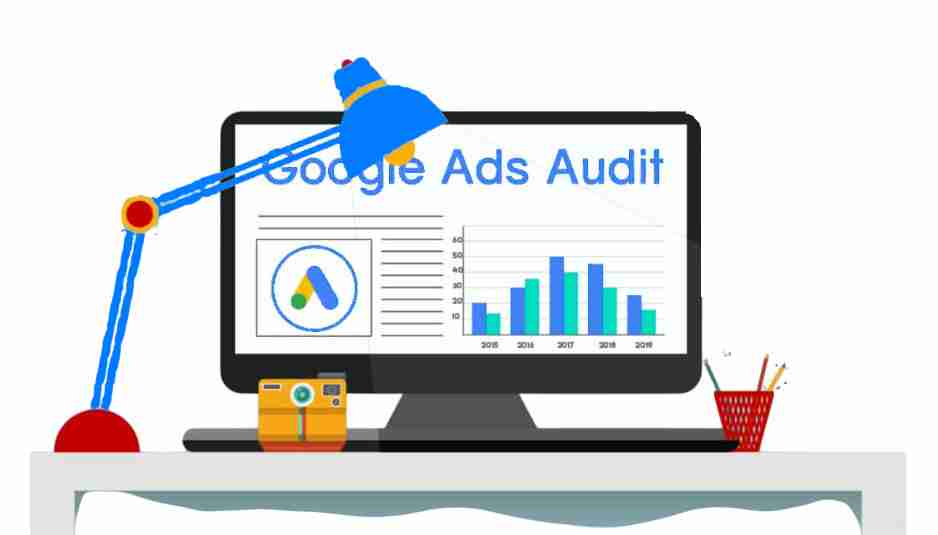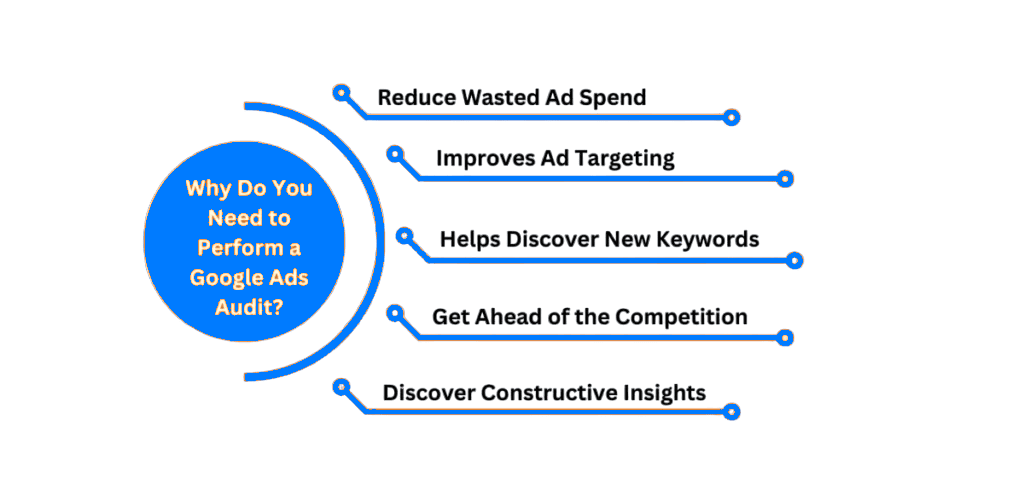
Adwords Account Audit Specialist
Google Ads Account Audit is a comprehensive evaluation of your ad strategies, focusing on critical performance metrics. Our 7-point analysis uncovers actionable insights, helping you optimize account structure, ad performance, targeting strategies, and more. This evaluation provides a clear roadmap to boost your return on investment (ROI).
Do You Need Google Ads Account Audit?
Are you spending $3,000 or more monthly on Google Ads? If so, you might not be fully leveraging your advertising investment. Our Google Ads Account Audit identifies opportunities, eliminates inefficiencies, and enhances your campaign performance. A Google Ads Account Audit Reveals Hidden Opportunities & Uncovers SERP Dominance Strategies.
Spending thousands on Google Ads without a data-driven, strategic approach can lead to wasted budget and missed opportunities. Our in-depth Google Ads Performance Audit provides a comprehensive evaluation of your campaigns. Identifying areas for improvement in ad performance, targeting, keyword strategy, and overall search engine visibility. We help you unlock maximum return on investment (ROI) by optimizing your campaigns for higher click-through rates (CTR), improved Quality Scores, and top SERP positions.

Complete Google Ads Audit Checklist
Campaign Settings and Goals
Effective campaign management starts with clearly defined settings and goals, aligning efforts with business objectives and enabling accurate performance measurement.
Conversion Tracking: The Foundation of Measurement
Accurate conversion tracking is crucial for understanding advertising impact. Track key actions like website actions (purchases, sign-ups), phone calls, and app installs. Regularly audit tracking setup for data integrity. Align goals with business objectives (leads, sales). Track both macro (primary goals) and micro conversions (engagement indicators) for a holistic view of the customer journey and to identify drop-off points. For deeper insights, explore resources on setting up conversion tracking in Google Ads (external link).
Campaign Goals: Defining Success Clearly
Defined campaign goals guide optimization and evaluation. Review campaign-level goals for clarity and accuracy, ensuring each campaign has a specific, measurable objective. Optimize each campaign for the appropriate goal (e.g., maximize conversions, maximize ROAS). Align campaign goals with overarching business objectives for maximum impact. Learn more about aligning campaign goals with business objectives within our knowledge base.
Bidding Strategies: Optimizing for Efficiency
Choosing the right bidding strategy impacts campaign performance and ROI. Analyze strategies like Manual CPC, Target CPA, and Maximize Conversions, understanding their strengths and alignment with campaign goals and data availability. Ensure strategies match campaign objectives and budget. Adjust bidding strategy to optimize for both volume and cost efficiency. Continuously monitor and adjust based on performance trends and business goal changes. For a comprehensive guide, see Google’s overview of Google Ads bidding strategies (external link).
Budget Settings: Managing Your Investment
Effective budget management maximizes ROI and prevents overspending. Identify and reallocate budget from underperforming campaigns. Review daily and monthly budgets, ensuring alignment with performance trends and ROI targets. Implement budget pacing rules to prevent overspending. For more in-depth guidance and strategic advice, explore our Google Ads Management services.
Ad Copy and Creative Strategy
Compelling ad copy and engaging creatives capture user attention and drive clicks. A well-defined strategy ensures resonance with your target audience and effective communication of your value proposition.
Effective Ad Copy: Words That Convert
- Craft compelling ad copy addressing target audience pain points.
- Highlight product/service benefits as solutions.
- Test multiple headlines and descriptions (A/B testing).
- Use clear call-to-actions (CTAs) to drive interaction (e.g., “Shop Now,” “Learn More”).
Learn more about writing effective ad copy in our ad copywriting guide.
Creative Strategy: Visual Storytelling
- Align ad creatives (images, videos) with campaign messaging and goals.
- Utilize high-quality visuals resonating with the target demographic.
- Test different creative approaches.
- Tailor creatives for each platform and ad format (e.g., responsive display ads, video ads).
Explore the power of visual storytelling in our section on visual advertising strategies.
Testing and Optimization: Continuous Improvement
- Set up A/B testing for ad copy and creatives.
- Use data-driven insights to refine messaging and creative assets.
- Monitor and adjust creatives regularly to prevent ad fatigue.
Unlock your visual advertising potential with our expert PPC Management Services.
Campaign Structure
A well-organized campaign structure enables efficient management, targeted advertising, and effective performance analysis, allowing for better budget allocation and relevant ad serving.
Organizing Campaigns: The Foundation of Your Account
- Structure campaigns based on business goals and target audiences (e.g., product line, location).
- Use consistent naming conventions for organization and tracking.
- Consider separate campaigns for different products/services for focused budgets.
Read our article on best practices for Google Ads campaign structure.
Ad Group Setup: Granular Targeting
- Ensure each ad group targets a specific set of closely related keywords or themes.
- Maintain tight relevance between keywords and ad copy to improve Quality Score.
- Limit keywords per ad group for better ad targeting (aim for 15-20).
Learn how to optimize your ad group structure for better performance.
Ad Rotation: Optimizing for Engagement
- Test different ad copy variations within each ad group.
- Set ad rotation to “optimize for best performing ads” for increased efficiency.
Performance Trends
Continuously monitoring and analyzing performance trends identifies optimization opportunities and ensures campaigns deliver desired results over time.
Monitoring Trends: Keeping a Pulse on Your Campaigns
- Regularly track key performance metrics (CTR, CPC, conversion rate, CPA, ROAS).
- Identify seasonal trends and adjust campaigns accordingly.
- Analyze the impact of external factors (market shifts, consumer behavior).
Stay updated on the latest digital marketing trends.
Data Analysis: Turning Insights into Action
- Use Google Ads and Analytics data to identify campaign performance patterns.
- Evaluate individual keyword and ad performance for optimization opportunities.
Learn how to leverage Google Analytics (external link) for deeper insights.
Adjustments and Optimizations: Driving Continuous Improvement
- Make real-time adjustments to bids, budgets, and targeting based on performance.
- Test new strategies (bidding, keywords) to improve underperforming campaigns.
- Use A/B testing to compare the performance of different strategies.
Keyword Strategy
A well-defined keyword strategy is the foundation of successful search engine marketing, targeting terms users search for.
Keyword Research: Finding the Right Terms
- Conduct in-depth keyword research using tools like Google Keyword Planner (external link), SEMrush, and Ahrefs.
- Consider both broad and long-tail keywords (high purchase intent).
- Use competitive keyword analysis tools.
Master the art of effective keyword research with our guide.
Keyword Mapping: Organizing for Relevance
- Organize keywords by themes for alignment with ad copy and landing pages.
- Map keywords to specific campaigns and ad groups for tight relevance.
Bid Strategies: Optimizing for Visibility and Efficiency
- Use automated bidding for high-volume keywords.
- Bid more aggressively on high purchase intent keywords.
Change History
The change history in Google Ads records all account modifications, crucial for understanding optimization impact and team accountability.
Tracking Changes: A Record of Your Optimizations
- Regularly review the change history log for adjustments to campaigns, keywords, and bids.
- Ensure all changes are documented and justified for insights into modification impact.
- Use the change history to learn from past optimizations and improve future strategies.
Landing Page Performance
Your landing pages are critical for campaign success, impacting conversion rates and cost per acquisition.
Landing Page Design: Creating a Seamless Experience
- Ensure landing pages are optimized for conversions with clear CTAs and mobile-friendly design.
- Use A/B testing to evaluate different landing page designs.
Optimize your website’s user experience for better conversions; learn more about website optimization.
Speed and Functionality: Ensuring a Smooth Journey
- Check landing page load times and address performance issues. Use Google PageSpeed Insights (external link).
- Ensure a seamless user experience across all devices.
Tracking and Optimization: Data-Driven Improvement
- Monitor landing page performance through conversion tracking (bounce rate, time on page, conversion rate).
- Optimize landing pages based on user behavior and performance data.
Additional Tools and Reports
Beyond core features, other tools and reports offer valuable insights for campaign optimization.
Google Ads Reports: Uncovering Valuable Data
- Leverage Google Ads reporting tools like the Search Terms report for new keywords.
- Use the Auction Insights report to monitor competitor activity.
- Utilize pre-defined and customize reports for specific data analysis.